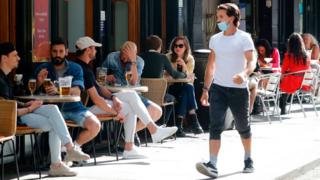
 Image copyright
Image copyright
Getty Images
The number of people in England testing positive for coronavirus may be levelling off, according to a household survey by the Office for National Statistics.
After a low in cases at the end of June, it estimated infections had been rising slightly in July.
Restrictions have been introduced in recent weeks in a number of different areas to control outbreaks.
The figures are based on throat and nose swabs from nearly 120,000 people.
They are tested whether they have symptoms or not.
Individuals in hospitals and care homes are not included in the ONS survey, which has been estimating cases in private households since May.
Figures for Wales have been included for the first time – and during the week of 27 July to 2 August, 1,400 people are estimated to have had Covid-19.
In England, the figure for the same week is 28,300 or one in 1,900 people.
Local lockdowns
However, there is uncertainty around these figures because they are based on modelling a sample of the population and a very small number of positive tests – just 53 people from 53 households over six weeks.
The ONS says there is no clear evidence from its survey to say whether infection rates differ by region in England.
Local restrictions are currently in place in 18 areas in Greater Manchester, West Yorkshire and East Lancashire, plus Leicester.
This means there are stricter rules on socialising for people living in these areas and for businesses, in order to control the spread of the virus.
Leicester was the first place in the UK to have a local lockdown introduced after a rise in Covid-19 cases. The city’s pubs and restaurants are now preparing for their first weekend open in months.
- CARE HOMES: The forgotten frontline struggling to protect residents against the killer virus
- TEMPERATURE CHECKS: Do they work or are they giving false reassurance?


